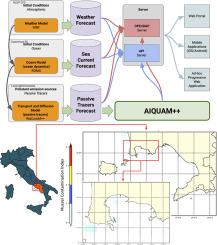A coupled Lagrangian-AI hierarchical and heterogeneous model for predicting bacteria contamination in farmed mussels
IF 6.2
2区 计算机科学
Q1 COMPUTER SCIENCE, THEORY & METHODS
Future Generation Computer Systems-The International Journal of Escience
Pub Date : 2025-09-06
DOI:10.1016/j.future.2025.108108
引用次数: 0
Abstract
The quality of coastal waters, particularly aquaculture zones, is crucial to sustainable development and human health. Traditional monitoring methods based on scheduled in-situ sampling are often too slow, costly, and limited in spatial and temporal coverage to meet the needs of large-scale aquaculture management. To overcome these constraints, we introduce the Artificial Intelligence-based Water QUAlity Plus Plus model (AIQUAM++), an AI-based modeling framework designed to predict E. coli contamination directly within farmed mussels. We evaluated and compared a suite of recent and high-performing machine learning architectures, such as K-Nearest Neighbors (KNN), and several Transformer-based architectures (Transformer, Informer, Reformer, TimesNet), to address the complex temporal dependencies within this time series classification (TSC) task. AIQUAM++ was trained with historical microbiological measures of E. coli levels in the mussels provided by the local authorities involved in food safety monitoring. The system architecture, featuring an inference engine completely written in C++ for high performance, leverages hierarchical parallelism to ensure scalability and computational efficiency, incorporating Message Passing Interface (MPI) for inter-process communication on multi-core architectures, OpenMP for multithreaded processing, and CUDA-based acceleration for GPU-optimized computations. This design enables high-throughput inference that is suitable for operational deployment in aquaculture monitoring networks. A test case application of AIQUAM++ was conducted in the Gulf of Naples (Campania, Italy). Empirical results demonstrated that the proposed system achieves classification accuracies that exceed 90 %, supporting its efficacy as a real-time data-driven decision support tool for aquaculture water quality management, minimizing health risks and contributing to sustainable marine resource governance.

预测养殖贻贝中细菌污染的拉格朗日-人工智能分层异质耦合模型
沿海水域,特别是水产养殖区的水质对可持续发展和人类健康至关重要。基于定期现场采样的传统监测方法往往速度太慢,成本高,空间和时间覆盖有限,无法满足大规模水产养殖管理的需要。为了克服这些限制,我们引入了基于人工智能的水质Plus Plus模型(aiquam++),这是一个基于人工智能的建模框架,旨在直接预测养殖贻贝中的大肠杆菌污染。我们评估并比较了一套最新的高性能机器学习架构,如k近邻(KNN)和几个基于变压器的架构(Transformer, Informer, Reformer, TimesNet),以解决这个时间序列分类(TSC)任务中复杂的时间依赖性。aiquam++接受了由参与食品安全监测的地方当局提供的贻贝中大肠杆菌水平的历史微生物测量方法的培训。该系统架构以完全用c++编写的高性能推理引擎为特点,利用分层并行性确保可扩展性和计算效率,结合消息传递接口(MPI)用于多核架构上的进程间通信,OpenMP用于多线程处理,以及基于cuda的gpu优化计算加速。该设计可实现高通量推断,适用于水产养殖监测网络的操作部署。在那不勒斯湾(意大利坎帕尼亚)进行了aiquam++的测试用例应用。实证结果表明,该系统的分类准确率超过90%,支持其作为实时数据驱动的水产养殖水质管理决策支持工具的有效性,最大限度地降低了健康风险,并有助于可持续的海洋资源治理。
本文章由计算机程序翻译,如有差异,请以英文原文为准。
求助全文
约1分钟内获得全文
求助全文
来源期刊
CiteScore
19.90
自引率
2.70%
发文量
376
审稿时长
10.6 months
期刊介绍:
Computing infrastructures and systems are constantly evolving, resulting in increasingly complex and collaborative scientific applications. To cope with these advancements, there is a growing need for collaborative tools that can effectively map, control, and execute these applications.
Furthermore, with the explosion of Big Data, there is a requirement for innovative methods and infrastructures to collect, analyze, and derive meaningful insights from the vast amount of data generated. This necessitates the integration of computational and storage capabilities, databases, sensors, and human collaboration.
Future Generation Computer Systems aims to pioneer advancements in distributed systems, collaborative environments, high-performance computing, and Big Data analytics. It strives to stay at the forefront of developments in grids, clouds, and the Internet of Things (IoT) to effectively address the challenges posed by these wide-area, fully distributed sensing and computing systems.

 求助内容:
求助内容: 应助结果提醒方式:
应助结果提醒方式:


